Teiid Code Analysis - Sequence Diagrams
Teiid Client
How a connection be created
Java programmer can use JDBC API with Teiid JDBC Driver create a JDBC Connection, for example
String url = "jdbc:teiid:Portfolio@mm://localhost:31000;version=1";
String user = "testUser";
String pass = "password";
Class.forName("org.teiid.jdbc.TeiidDriver");
Connection conn = DriverManager.getConnection(url, user, pass);
the below sequence diagram shows how DriverManager create a connection:
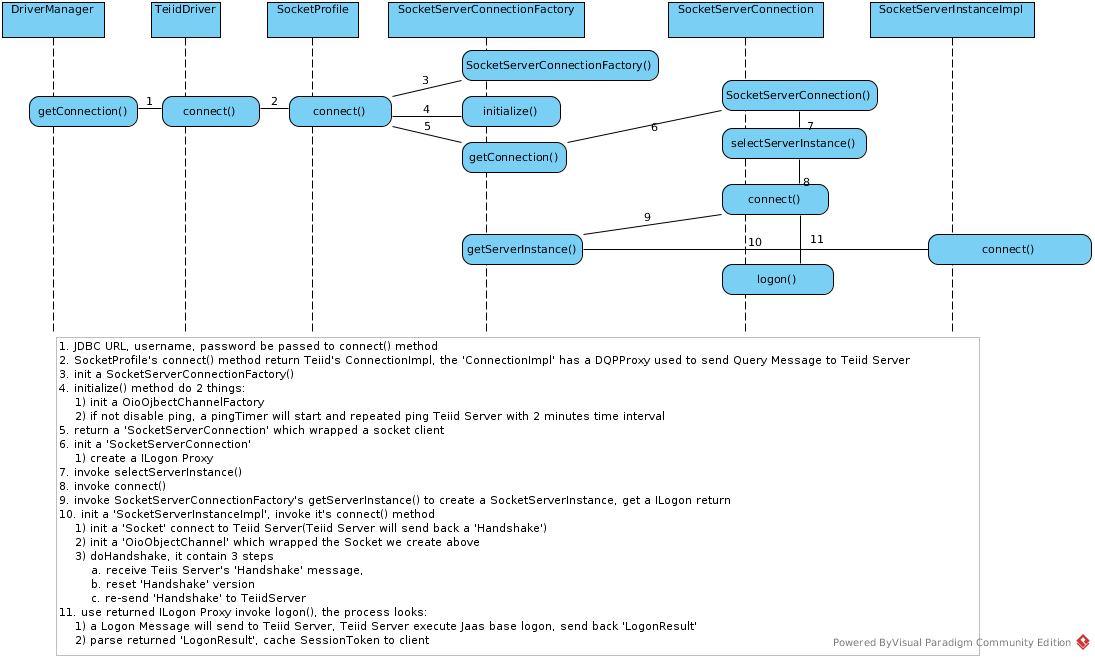
ILogon
Step 6, in SocketServerConnection’s construct method, a ILogon Proxy created, org.teiid.net.socket.SocketServerInstanceImpl.RemoteInvocationHandler is the InvocationHandler, it looks:
Class<ILogon> iface = ILogon.class;
Class<?>[] interfaces = new Class[] {iface};
InvocationHandler h = new SocketServerInstanceImpl.RemoteInvocationHandler(iface, false){};
Object proxy = Proxy.newProxyInstance(loader, interfaces, h);
ILogon logon = iface.cast(proxy);
NOTE: org.teiid.net.socket.SocketServerInstanceImpl.RemoteInvocationHandler has defined a getInstance() abstract method, eatch time the InvocationHandler implement, a org.teiid.net.socket.SocketServerInstance be return.
OioObjectChannel
Step 10 - UML of OioOjbectChannel, note that, ObjectChannel has 2 implementations, OioOjbectChannelFactory for client, and org.teiid.transport.SSLAwareChannelHandler.ObjectChannelImpl for Server.
The client side org.teiid.net.socket.OioOjbectChannelFactory.OioObjectChannel mainly contains 2 stream:
org.teiid.netty.handler.codec.serialization.ObjectEncoderOutputStream- used to write Client Message to Serverorg.teiid.netty.handler.codec.serialization.ObjectDecoderInputStream- used to read Message from Server.
DQP
In org.teiid.jdbc.ConnectionImpl’s construct method, a DQP proxy created, org.teiid.net.socket.SocketServerInstanceImpl.RemoteInvocationHandler is the InvocationHandler, it looks:
Class<ILogon> iface = DQP.class;
Class<?>[] interfaces = new Class[] {iface};
InvocationHandler h = new SocketServerInstanceImpl.RemoteInvocationHandler(iface, false){};
Object proxy = Proxy.newProxyInstance(loader, interfaces, h);
DQP dqp = iface.cast(proxy);
How a connection be created in embedded
In embedded, the url are much more simple, no username/password is necessary, the driver can get from EmbeddedServer directly:
String url = "jdbc:teiid:Portfolio";
Connection conn = server.getDriver().connect("jdbc:teiid:TeiidSizingApplication", null);
the below sequence diagram shows how a connection be created in embedded:
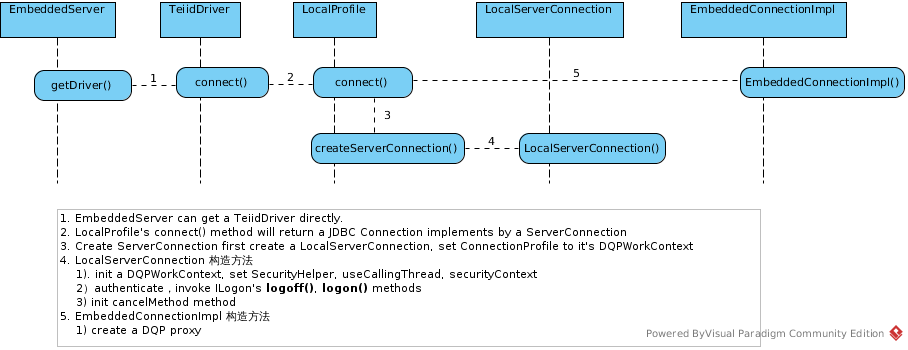
How a Statement execute the query
Assuming view ‘Marketdata’ existed in Teiid VDB, a JDBC client execute query like:
Statement stmt = conn.createStatement();
stmt.executeQuery("SELECT * FROM Marketdata");
the below sequence diagram shows how query sql SELECT * FROM Marketdata be sent to Teiid Server

- StatementImpl executeQuery receive the query sql
SELECT * FROM Marketdata - StatementImpl assemble a
org.teiid.client.RequestMessagebase query sql, then invoke DQP Proxy’s executeRequest - RemoteInvocationHandler’s invoke method be invoked
- RemoteInvocationHandler assemble a
org.teiid.net.socket.Messagebase on passedorg.teiid.client.RequestMessage, then SocketServerInstanceImpl’s send method be invoked - OioObjectChannel’s write methd be invoked
- ObjectOutputStream which come from socket writeObject
org.teiid.net.socket.Message
How a Statement execute the query in embedded
Assuming view ‘Marketdata’ existed in Teiid VDB, a JDBC client execute query like:
Statement stmt = conn.createStatement();
stmt.executeQuery("SELECT * FROM Marketdata");
Connection create Statement sequence diagram as below:
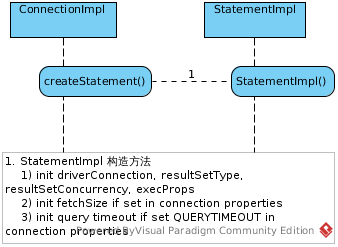
the below sequence diagram shows StatementImpl how query sql SELECT * FROM Marketdata be sent to Teiid Server
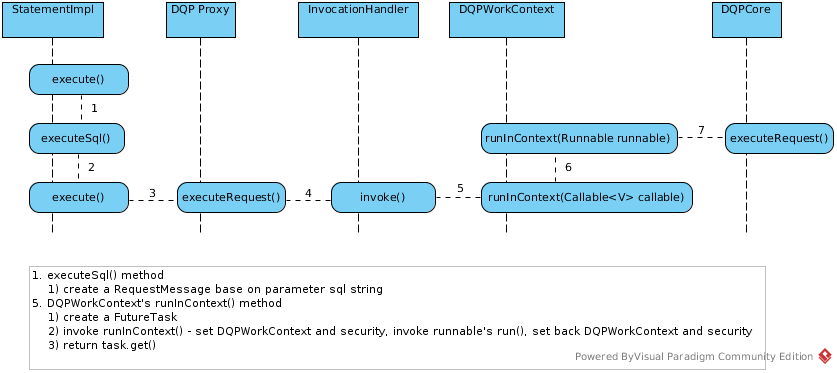
How ResultSet get Next
Continue with above Statement execute Query, ResultSet get Next like
ResultSet rs = stmt.getResultSet();
rs.next();
the below sequence diagram shows how ResultSet get Next

How Teiid Server handle query request

- SSLAwareChannelHandler
While Teiid Server Started, it will create a SocketListener which listen for new connection requests and create a SocketClientConnection for each connection request.
The SocketListener bootstrap netty server worker threads with port number 31000, SSLAwareChannelHandler is the handler used by netty server side, it’s messageReceived() can be thought as teiid server side entry point. Once a client request in, this method be first invoked.
- SocketClientInstance
Sockets implementation of the communication framework class representing the server’s view of a client connection. Implements the server-side of the sockets messaging protocol. The client side of the protocol is implemented in SocketServerInstance.
It’s processMessagePacket() method be invoked for handling income request message.
- DQPWorkContext & ServerWorkItem
ServerWorkItem is a runnable class, it encapulates income request message in it’s constructor:
public ServerWorkItem(ClientInstance socketClientInstance, Serializable messageKey, Message message, ClientServiceRegistryImpl server) {
this.socketClientInstance = socketClientInstance;
this.messageKey = messageKey;
this.message = message;
this.csr = server;
}
DQPWorkContext is a filed of SocketClientInstance, DQPWorkContext’s runInContext() method be invoked, the constructed ServerWorkItem passed as a argument. Then ServerWorkItem’s run() method be invoked.
Teiid Engine
DQPCore execute request
DQPCore implements client interface DQP, it has defined a ‘executeRequest’ method:
public ResultsFuture<ResultsMessage> executeRequest(long reqID,RequestMessage requestMsg) throws TeiidProcessingException;
what ‘executeRequest’ method is a Entry Point for client request, it has parameter RequestMessage which contains client query command, and the method return ResultsMessage which contains the tuple results.
The below sequence diagram shows how DQPCore’s ‘executeRequest’ method run and return a ResultsMessage:

- 1 StatementImpl invoke DQPCore’s
executeRequest()method with RequestMessage as parameter - 2 Request and RequestWorkItem initialize
- 3 - 5 http://ksoong.org/teiid-dqp/
- 6 Refer to below
BatchCollector collect tuplessection
BatchCollector collect tuples
BatchCollector collect tuples are related with BufferManager, the sequence diagram as below

- 1 collectTuples first invoke QueryProcessor’s nextBatch() method get the
TupleBatch, then invoke flushBatch() method withTupleBatchas a parameter - 2 If TupleBatch’s row count is 0 and TupleBatch’s Termination flag is NOT_TERMINATED flushBatch() method return, else invoke flushBatchDirect() method with
TupleBatchas a parameter - 3 Invoke TupleBuffer’s addTupleBatch() method to add
TupleBatchto TupleBuffer; - 4 addTupleBatch() first update TupleBuffer’s rowCount then recursively invoke addTuple() method to add each
Tupleto TupleBuffer; - 5 addTuple() first create a temporary ResizingArrayList, add all
Tupleto this list, then invoke saveBatch() method - 6 BatchManager’s createManagedBatch() be invoked return a
mbatchas Batch Id; addmbatchto batches TreeMap; rest temporary ResizingArrayList to null; - 7 update BatchManagerImpl’s totalSize with the total size of Tuples in ResizingArrayLise; update BatchManagerImpl’s rowsSampled with ResizingArrayList’s size; BufferManagerImpl’s batchAdded getAndIncrement; Create CacheEntry and add CacheEntry’s id to BufferFrontedFileStoreCache’s physicalMapping map(BatchManagerImpl id is Key, Batch Id is Value); Invoke addMemoryEntry() method with CacheEntry as parameter; return Batch Id;
- 8 Invoke persistBatchReferences(); add CacheEntry to BufferManagerImpl’s memoryEntries map(CacheEntry’s Id is Key, CacheEntry is Value); add CacheEntry to BufferManagerImpl’s initialEvictionQueue; update BufferManagerImpl’s activeBatchBytes
- 9 TIDO–
DataTierTupleSource getResults
Continue with DQPCore execute request, below sequence diagram shows how DataTierTupleSource interact with Translator layer and getResults AtomicResultsMessage
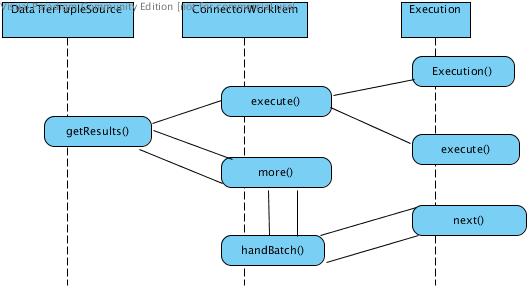
execute()
Its main function is create a translator Execution, then invoke Execution’s execute() method, the completed procedure like:
- Create Data Source Connection base on JCA connector implementation
- Create translator Execution with translator ExecutionFactory
- Invoke translator Execution’s execute() method
more()
Usually this methods be invoked after execute(), this method will invoke Execution’s next() method repeatedly, return list of rows existed in data source.